The Comprehensive Geode Map: A Collector's Guide
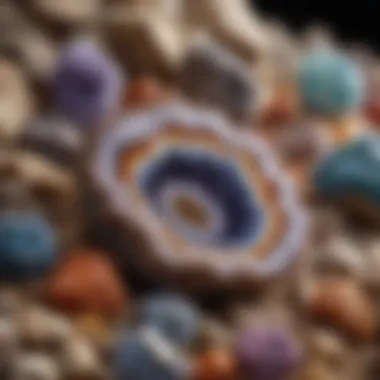
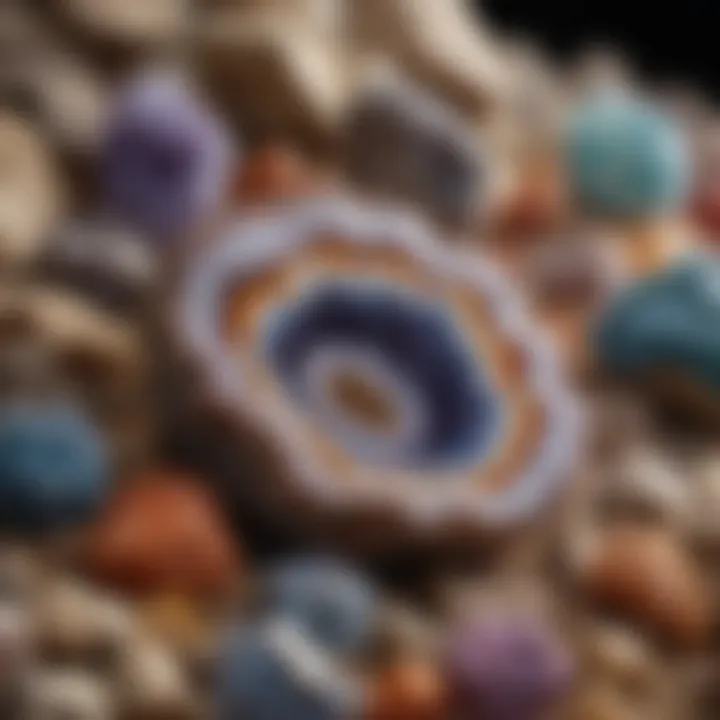
Intro
Geodes are nature's little surprises, often lurking in inconspicuous rocks. These formations, with their sparkling crystals nestled inside, tell stories of the Earth’s geological past. For collectors, understanding geodes goes beyond mere aesthetics; it encompasses a blend of geology, paleontology, and a touch of adventure. This guide aims to illuminate the significance of geode maps, offering insight into the art of locating these treasures. Let’s dive into the intricate world of geodes, where curiosity meets knowledge.
Featured Collectible of the Month
Overview
This month, we shine a spotlight on the Amethyst Geode, a collector's delight known for its stunning violet hues and crystal formations. Found primarily in volcanic rocks, these geodes encapsulate a variety of quartz crystals, vibrating with a unique energy that has captivated collectors for generations. The allure of amethyst, mesmerizing in color and formation, stands as a testament to the geological processes at play beneath the Earth’s crust.
Historical Significance
Historically, amethyst geodes have held a significant place in various cultures. Ancient Greeks believed that wearing amethyst could prevent drunkenness. Furthermore, it was utilized by royalty, often seen in regalia, signifying both power and wisdom. Today, these geodes are not just collectibles but also carry a legacy, connecting us to the past while enjoying their aesthetic beauty in modern settings.
Identification Techniques
Visual Characteristics
Identifying geodes can be as tricky as finding a needle in a haystack, but with a keen eye, one can spot the clues. Here are a few visual traits to look for when identifying a geode:
- Shape: Generally spherical or oval.
- Surface: Often rough or bumpy, sometimes resembling an ordinary rock.
- Color: Colors can range from dull gray to vibrant orange, purple, or blue, depending on mineral content.
Tip: When you find a rock that feels heavier than it looks, you might be onto something.
Resources for Identification
Learning to identify geodes can be a journey filled with delightful discoveries. A few resources to sharpen your skills include:
- Books: "Rocks and Minerals" by Fred Pough offers in-depth visual guides.
- Online Communities: Websites like reddit.com host lively discussions about geode identification.
- Local Workshops: Many geology clubs offer workshops to help enthusiasts learn the ropes.
"A geode's true beauty is often hidden beneath a rough exterior, much like the best treasures in life."
Equipped with the right knowledge and resources, you can embark on your own journey of geode hunting, transforming your curiosity into collections that reflect the rich tapestry of Earth's hidden treasures.
Understanding Geodes
When discussing the geological marvels that adorn the Earth, geodes stand out as true enigmas. Their study not only feeds a collector's curiosity but also provides insight into various Earth processes. Understanding geodes enriches the collector's journey, offering guidelines on where to find these hidden treasures, and allowing for a deeper appreciation of nature's artistry. Knowing how geodes form and the different types can enhance the thrill of discovery during a hunt.
Defining Geodes
Geodes are spherical rock cavities, often lined with minerals that can be quite spectacular. These formations start as hollow spaces within volcanic or sedimentary rocks and evolve into stunning crystalline structures over time. Simply put, a geode can be thought of as nature's mysterious gift, perfectly encapsulating the beauty that lies beneath the Earth's surface. Many enthusiasts find joy in cracking open geodes, revealing their vibrant interiors. The hidden wonders within become not just specimens to admire, but personal stories waiting to be told.
The Formation Process
The journey of a geode from a mere hollow rock to a gleaming gem involves complex processes, shaped by time and natural forces. The following subsections delve deeper into this fascinating metamorphosis.
Natural Processes
Out in the wild, nature plays its hand in forming geodes through various environmental phenomena. Over time, volcanic eruptions, erosion, and sedimentation contribute to the creation of these geological wonders. What makes this process so captivating is its unpredictable nature; each geode tells a different story, shaped by unique conditions. Its spontaneity makes direct observation challenging, but this very uncertainty adds to the thrill of geode hunting. The key takeaway here is that while some geodes form quickly, others may take thousands of years, offering a glimpse into the slow-moving processes of our planet.
Mineral Infiltration
Another critical aspect of geode formation is mineral infiltration. When mineral-rich water seeps into the hollow spaces of rocks, it begins to deposit these minerals over time. This process is crucial for creating the colorful interiors found in many geodes. The most common minerals to infiltrate include quartz, calcite, and amethyst, each imparting its unique hue and character. The uniqueness of mineral infiltration lies in its ability to transform an ordinary rock into a breathtaking treasure trove, making it an essential element in the lifecycle of geodes. Collectors often seek certain mineral deposits, enhancing the collectible value of their finds.
Crystallization
Finally, crystallization brings the portrait of geode formation to completion. As minerals continue to settle in a geode, they can crystallize at different rates, leading to a diverse range of shapes and sizes. The beauty of crystallization is seen in the various formations, from sharp, spiky quartz points to smooth, rounded calcite. It is this aspect that captivates both scientists and enthusiasts alike. However, crystallization requires specific conditions to occur, including the right temperature and pressure, which means not all geodes exhibit the same structural beauty.
Types of Geodes
Understanding geodes also involves recognizing their varied forms. Each type possesses distinct characteristics that make them desirable among collectors, and discovering these variations can significantly enhance one’s geode-hunting experience.
Quartz Geodes
One of the most popular types of geodes is the quartz geode, known for its striking beauty and widespread occurrence. These geodes typically have a central cavity filled with clear or milky quartz crystals. The allure of quartz geodes lies in their transparency and versatility, making them perfect for display or crafting. As a first-time collector, they are often recommended due to their availability and affordability. The potential benefit here is that quartz geodes can often be found in various locations across the globe, making them an accessible target for collectors of all levels.
Amethyst Geodes
Amethyst geodes are particularly valued, thanks to their rich purple crystals that capture attention. Unlike quartz, amethyst geodes can sometimes fetch higher prices due to their color and the rarity of finding large specimens. Their luxurious appearance gives them a unique place in both geology and the gemstone trade. For those interested in beauty and lore, amethyst is often associated with tranquility and clarity of the mind, adding an extra dimension to their appeal. However, the rarity of sizeable amethyst geodes can present challenges for collectors, making them more of a prized find.
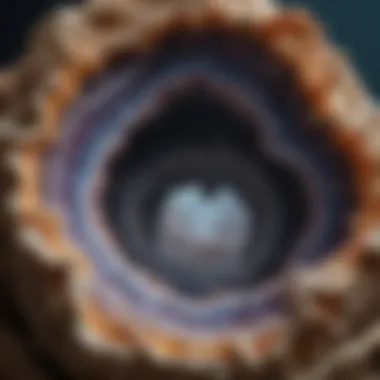
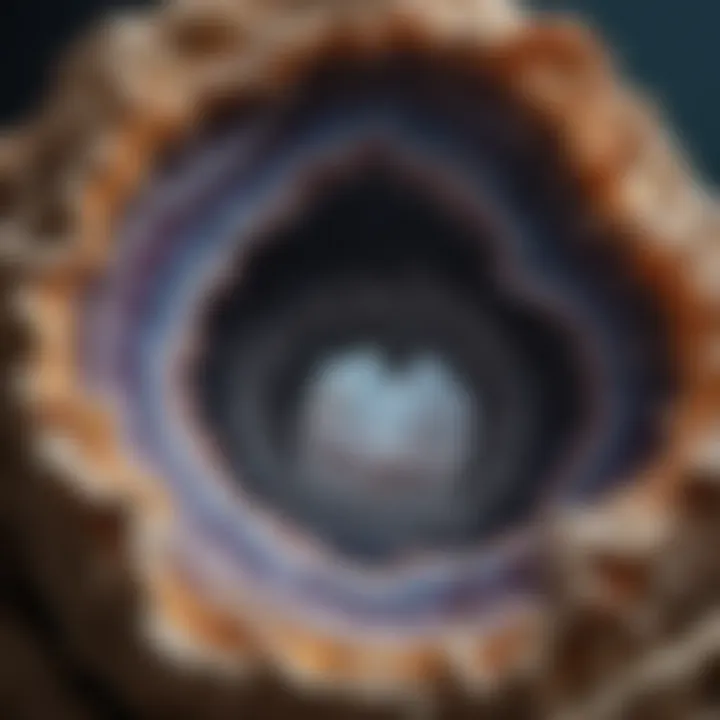
Calcite Geodes
Calcite geodes offer yet another dimension to the world of geodes. These can appear in shades of white, yellow, and even pink, depending on the mineral mix. What sets calcite apart is its reactive properties; it can fizz when it comes into contact with acid, providing a unique method for testing its authenticity. The distinct appearance and interactive features make calcite geodes attractive for collectors and educators alike, allowing for practical insights into mineral science. However, due to their composition, calcite geodes may require more careful handling than other types.
Unique Variants
Beyond the mainstream types, unique variants of geodes exist, which can dazzle collectors with their originality. These may feature unusual crystalline patterns, unexpected minerals, or even geodes formed in unconventional shapes. The special characteristic of these variants is their intrinsic unpredictability—their rarity often comes with unique forms, sizes, or colors that aren’t typically found in well-known geodes. This exclusivity can make them the crowning jewels in any collection, but they may require more expertise and patience to find.
What Is a Geode Map?
Geode maps serve as indispensable tools in the world of collectors and geology enthusiasts alike. Diving into the concept of a geode map allows us to understand not just the practicality it offers, but also its inherent value in unearthing a treasure trove of Earth's geological wonders. A well-crafted geode map can mean the difference between a fruitful quest for these stunning formations and a day filled with potential disappointment.
A geode map typically indicates locations where geodes can be discovered, providing hints about the types of geodes present in those areas. By mapping out regions based on various geological formations, collectors can navigate with more precision and confidence, knowing exactly where they might find these hidden gems.
Defining Geode Maps
When we talk about geode maps, it's essential to clarify what we mean. These maps act as guides that pinpoint specific sites known for geode deposits. They can include a variety of information such as topographical details, geological formations, and even historical notes about previous finds in that area. Unlike your standard map of highways and streets, geode maps focus on the geology and the secrets that lie beneath the surface.
Moreover, geode maps can vary widely in their detail and format. Some might be hand-drawn by seasoned collectors who wish to share their findings. Others may come from geological studies, featuring advanced mapping software to illustrate the most promising areas for searching. Regardless of their origins, the primary role remains the same: guiding the collector to potential discoveries.
Purpose of Geode Maps
Understanding the purpose of geode maps elevates the practice of collecting to a strategic endeavor. Each purpose they serve is interwoven into the greater fabric of exploration and knowledge acquisition.
Guided Exploration
At the heart of geode maps lies guided exploration, a term that encapsulates the essence of using these maps. They act as signposts on a journey through rocky terrains and dusty trails. This aspect is vital because it directs collectors to specific locations known for their geode abundance. The most significant characteristic of guided exploration is its ability to save time and effort. Instead of casting a wide net, collectors can zone in on areas with higher yields.
However, one must acknowledge the unique feature here: local expertise. Maps that are drawn from firsthand experiences often highlight hidden gems that aren’t documented in scientific databases. Though these maps may lack formal recognition, they hold a treasure of insider tips that can spearhead your exploration.
Collecting Strategies
Another important aspect of geode maps is their value in collecting strategies. They provide critical insights into not only where to look but also how to approach collection in a structured manner.
A key characteristic of this purpose is its systematic approach to gathering. With locations mapped out, collectors can focus their efforts and resources efficiently. Strategies can be tailored based on time of year, weather conditions, and even local access regulations. Unique features of these strategies include the ability to create a checklist for locations to visit, ensuring that each trip is meticulously planned. Though this structured approach has its advantages—such as maximizing finds—some might feel it takes away from the spontaneity of rock hunting, which can also be part of the joy.
Educational Insights
Geode maps also play a significant role in providing educational insights. They function not only as navigational tools but also as learning aids for geology enthusiasts.
Their primary characteristic lies in imparting knowledge about the geological landscape. Knowing the types of rock formations and the geological history of a visiting location can significantly enhance the collecting experience. A unique feature is how these maps can link to geological surveys and other educational resources, making them practically invaluable for both amateur and expert collectors.
While the educational aspect is a major benefit, some maps may require a certain level of prior knowledge to fully understand their contents, which may be a slight hurdle for complete novices.
In summary, geode maps bridge practical exploration with a deeper understanding of geology, enriching the collector's experience while also highlighting the beauty of Earth's hidden treasures.
Creating a Geode Map
A geode map is not merely a collection of points on a piece of paper or a digital screen; it’s a curated guide that can unlock the treasures hidden beneath the ground. Creating such a map involves understanding the geology of an area, appreciating the nuances of different geodes, and using various tools and resources effectively. This process benefits collectors significantly, making their search for geodes more structured and efficient.
Research and Compilation
The backbone of creating an effective geode map is thorough research. This means surfacing data about specific regions known for their geode deposits. Local geological surveys often provide invaluable insights. You’ll want to track down reports on past finds and documented geological formations. Seeking information from local rockhounding clubs or collectors can yield nuggets of wisdom that aren't in textbooks.
Gathering this data is like piecing together a puzzle; each fragment of information adds to the overall picture of where to find the most stunning geodes.
Technological Tools and Resources
Digital Mapping Software
Digital mapping software can be a game-changer in creating geode maps. Applications like Google Earth or specialized software can assist in layering geological features, making your research visually intuitive. These tools allow you to mark locations of previous finds, forecast movements based on surrounding geology, and visualize potential site accessibility.
One significant advantage of digital mapping software is its ability to continuously update as new data emerges. However, sometimes software can be overly complicated for newcomers, requiring a learning curve that might deter some.
Field Surveys
Field surveys bring a practical dimension to the creation of geode maps. By physically examining areas, you can verify information gleaned from research. It’s one thing to read about a potential site; it’s another to feel the ground under your feet and see the formations first-hand. Surveys can often lead to unexpected discoveries.
One key aspect of field surveys is they help in identifying environmental factors, like waterflow patterns, that can lead to new geodes. That said, physical exploration can be time-consuming and sometimes perilous, depending on the terrain you find yourself in.
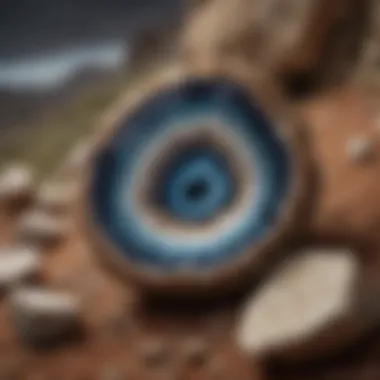
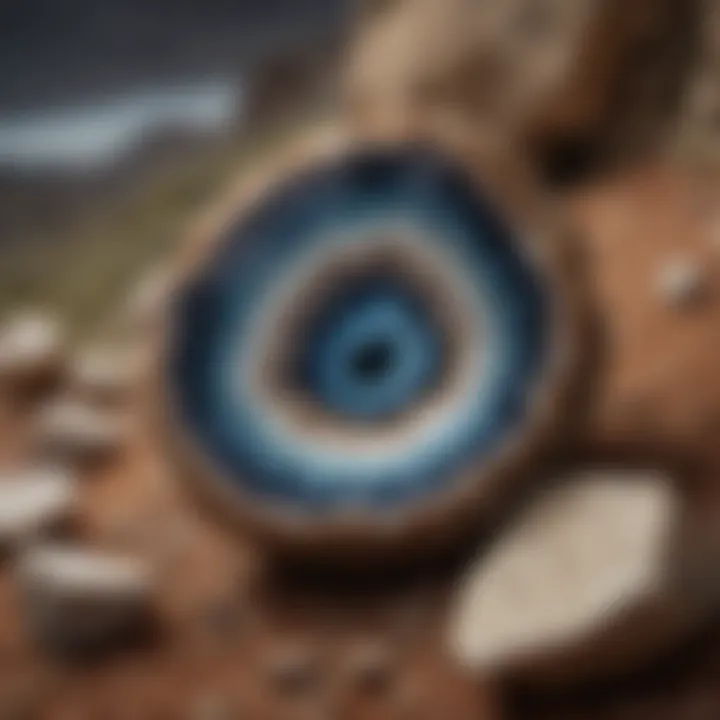
Geological Databases
Geological databases are a treasure chest of information. These databases aggregate data from various sources, offering insights into regional geology, historical finds, and mineral compositions. They act as a central hub for collecting expansive details that can significantly enhance your map-making process.
The ease of accessing large volumes of data makes geological databases an excellent choice for collectors. However, the challenge lies in navigating these databases, as some might find the information overwhelming or too technical.
Collaboration with Experts
Working with experts is perhaps one of the most beneficial aspects of creating a geode map. Geologists and mineralogists often have insights that can save you from unnecessary detours during your exploration. Establishing a connection with them can lead to collaborations that provide a deeper understanding of regional geology and potential geode-rich areas.
Additionally, participating in workshops or seminars can expose you to new techniques and methodologies that can further refine your map-making process. These relationships can also open more doors when it comes to field surveys, granting you access to restricted areas or curated information, all of which can enrich the content of your map.
By weaving together research, technology, and expert collaboration, creating a geode map transforms from a mere idea into a comprehensive tool that supports both novice collectors and seasoned pros alike.
Using Geode Maps for Exploration
Geode maps arguably serve as the compass for enthusiasts who are eager to uncover the geological treasures hidden beneath the earth’s surface. By utilizing these maps, both novice collectors and seasoned experts can pinpoint optimal locations for their hunt. The significance of these maps lies in their ability to transform the often arduous task of searching for geodes into a more systematic and fruitful endeavor.
Key benefits of using geode maps include:
- Efficient Planning: A well-constructed geode map provides insight into geographic areas known for specific types of geodes, helping collectors focus their efforts.
- Increased Success Rates: By honing in on proven hotspots, collectors significantly boost their chances of striking it rich.
- Educational Value: These maps also educate users about regional geology, making the exploration not just about collecting, but also learning.
Best Practices for Geode Hunting
Preparation and Equipment
Preparation is the bedrock of a successful geode hunting trip. From appropriate attire to tools, getting ready is crucial.
Having the right gear is non-negotiable. Tools like hammers, chisels, safety goggles, and sturdy gloves are indispensable. They ensure not only safety but also enhance efficiency in locating and opening geodes.
The key characteristic of good equipment is its ability to withstand the rigors of outdoor exploration. For instance, hammers designed specifically for rock hunting allow for cleaner strikes with minimal risk of damaging the geode within.
Moreover, investing in a quality backpack to hold all your tools can’t be overlooked; a good pack distributes weight evenly, making the trek manageable.
Effective Search Techniques
When it comes to hunting for geodes, techniques wield significant weight. It's not enough to just walk into a field with a hammer; having a game plan is essential.
The hallmark of effective search techniques involves understanding where geodes are likely found. Areas with volcanic rock formations, river beds, or eroded hillsides are prime spots.
Unique features of such techniques include the practice of looking for specific signs like rounded stones or clusters in the ground. Spotting these indicators can lead you to rich finds, making the approach highly advantageous. However, this method does require a keen eye and somewhat of an intuitive feel for the landscape, which may take time to develop.
Ethics in Collecting
Respecting Nature
Every collector must wear the hat of an environmental steward. Respecting nature is not just a nice-to-have; it’s a critical aspect of responsible collecting
Being mindful of the ecosystem while hunting for geodes is beneficial. This means avoiding areas with sensitive habitats and ensuring not to disturb local wildlife.
Also, practicing Leave No Trace principles, such as cleaning up after oneself, helps preserve the locales for future generations of collectors.
Legal Considerations
Navigating the legal landscape when geode hunting can be tricky. Familiarizing oneself with local collecting laws is paramount to ensure compliance.
Often, collectors might stumble into trouble without even knowing it. For example, many state parks and protected lands prohibit the removal of any natural materials. Ignoring these regulations can lead to hefty fines or worse, tarnishing the reputation of the geode-collecting community.
The unique feature of adhering to legal considerations is that it promotes sustainable collection practices. Being aware of laws and regulations not only ensures a worry-free expedition but also fortifies the standing of collectors as responsible participants in the geological community.
"Collecting geodes is as much about responsibility as it is about the thrill of the hunt."
In summary, using geode maps effectively while being ethically grounded enhances both the enjoyment and sustainability of the hobby. By preparing adequately and employing the right techniques, coupled with responsible practices, collectors can relish in their exploration and discoveries.
Geodes in Culture and Science
Exploring the cultural and scientific significance of geodes provides a deeper understanding of their role beyond mere collection. Geodes have inspired artists, scientists, and the general public, manifesting in various forms of expression and inquiry. This section will delve into two primary areas: geodes in art and their scientific significance, illustrating how these geological wonders permeate our lives in unexpected ways.
Geodes in Art
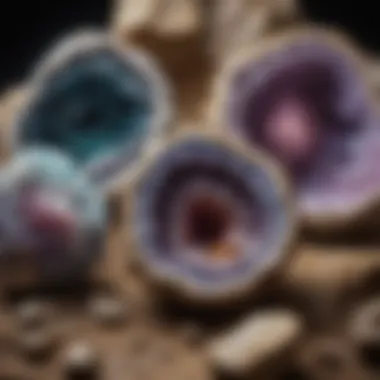
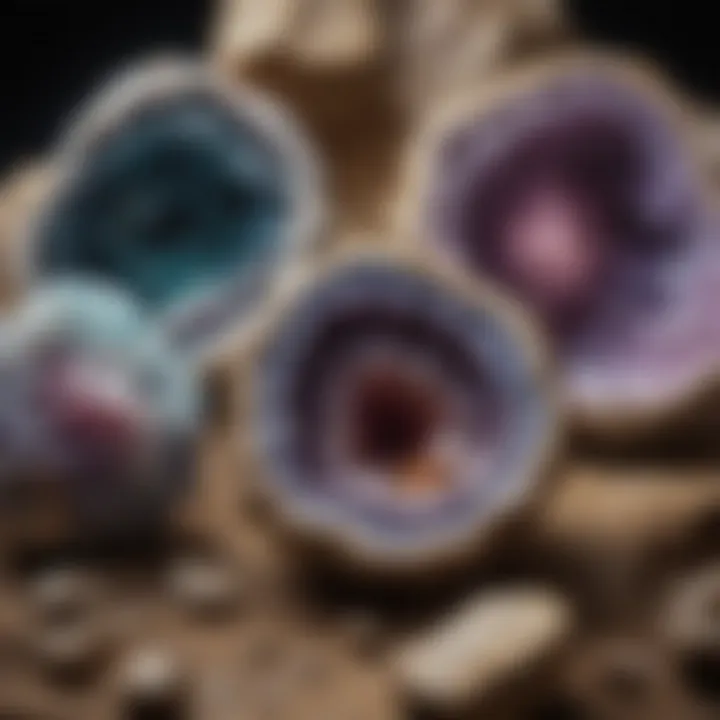
Geodes captivate artists with their stunning aesthetics. The contrasts between the rough, exterior shell and the glittering crystalline interior create a compelling visual narrative. Artists often use geodes in home decor items such as coasters, tabletops, and wall hangings, bringing a touch of nature's beauty indoors. Additionally, some sculptors carve geodes into intricate shapes, showcasing the structural complexities hidden within.
- Symbolism: In many cultures, geodes symbolize personal growth and transformation due to their fascinating formation process. They serve as a reminder that beauty often lies within, urging individuals to look beyond superficial appearances.
- Inspiration for Artists: Geodes have sparked movements in contemporary art, where they are used in mixed media installations to convey themes of nature, mystery, and geology. Artists continue to reinterpret these natural forms, bridging the gap between art and science.
Scientific Significance
The study of geodes has significant implications in both geological research and educational frameworks. This twofold perspective sheds light on their importance.
Geological Studies
Geological studies involving geodes contribute immensely to our understanding of the Earth's history. By analyzing the mineral composition and formation environments of geodes, scientists gain insights into the geological processes that shaped our planet. This is particularly relevant in the discussion of:
- Key Characteristics: Geodes often serve as indicators of past volcanic activity or hydrothermal conditions, making them invaluable for geological insights.
- Studies of Mineralization: Understanding how minerals infiltrate and crystallize within a geode can lead to advancements in mineralogy and help uncover patterns in the Earth's crust.
While geological studies yield rich data, they can also pose challenges. The specificity of conditions that lead to the formation of certain types of geodes can make them difficult to generalize beyond local regions.
Educational Applications
In educational contexts, geodes serve as engaging learning tools. Geology educators harness their allure to teach students about mineralogy, crystallography, and tectonic processes.
- Key Characteristics: The tactile nature of geodes makes them perfect specimens for hands-on learning experiences. Students get to explore real geological specimens, enhancing their understanding of complex concepts through direct interaction.
- Practical Learning: Using geodes in lessons can stimulate curiosity and foster a love for the sciences. This practical application cultivates an appreciation for Earth's natural wonders.
However, depending on the educational framework, the availability of geodes and certain related resources may pose limitations. Teachers must find ways to adapt lessons to accessibly convey the scientific marvels that geodes represent.
Geodes in Popular Culture
Beyond their aesthetics and scientific importance, geodes have infiltrated popular culture, appearing in everything from fashion trends to social media. They are often featured in jewelry, homemade crafts, and home décor, symbolizing not just beauty, but a connection to the Earth. Their rise in popularity on platforms like Instagram and Pinterest showcases the ongoing fascination with these natural formations.
In summary, geodes have cemented their place not just as geological wonders but as cultural artifacts and educational tools. Their relevance spans disciplines and engages a diverse audience, from the passionate collector to the casual observer. By appreciating the multifaceted significance of geodes, we embrace both their beauty and their contribution to our understanding of Earth and art.
Preservation and Care
Preserving and caring for geodes is fundamental, especially for collectors who invest time and resources into their collections. Geodes can be delicate, with their internal crystals vulnerable to damage from mishandling or environmental factors. Proper care ensures that these natural treasures maintain their beauty and structural integrity for years to come.
Handling Your Finds
Once you've unearthd a geode, the way you handle it is crucial. First impressions matter. If you grab it without caution, you could find yourself with a chipped or cracked specimen in no time. Gently wash any dirt away with soft, lukewarm water and a non-abrasive cloth. Avoid using harsh chemicals or scrubbing pads that can scratch the surface. Think of it like handling a newborn baby; a gentle touch goes a long way.
Maintaining the original condition is all about respecting the geode’s natural formation. Remember, the outside appearance can often hint at the beauty within.
Display Techniques
An impressive collection deserves an equally captivating display. The way in which your geodes are displayed can enhance their visual appeal, allowing you to share your passion with others while also protecting them from wear and tear. Here are two vital aspects to consider:
Creating a Display Case
Creating a display case is not just about aesthetics; it serves to protect geodes from dust, moisture, and accidental knocks. The ideal display case should be made from sturdy glass because it provides clear visibility without compromising the structural safety of the specimens inside.
One of the key characteristics of a well-designed display case is that it offers UV protection, preventing harmful rays from fading the colors and details of the geodes over time. While it might be tempting to save money with a makeshift solution, investing in a proper case pays off in the long run.
The unique feature here is the adjustable shelving, which allows for flexibility in presentation. It can accommodate varying sizes and shapes while giving the collector room to grow their collection without needing another case too soon. However, the challenge can be finding a suitable, elegant design that fits well with your home decor.
Lighting Considerations
Lighting is an often-overlooked aspect of geode displays. It plays a significant role in enhancing the aesthetic presence of geodes. Natural daylight can be uplifting; however, it can also cause fading and damage over time. That’s why using LED lights with adjustable brightness can be the way to go. They not only highlight the intricate crystal formations but also have a long lifespan and run cooler than traditional bulbs.
One of the advantages of careful lighting is that it can draw attention to unique features of the geode. Deep blues and purples in amethyst geodes, for instance, shine like the night sky under proper illumination. Though be careful—too bright, and those vibrant colors might change into a dull hue. Choosing the right intensity can make or break the display.
Maintenance of Geodes
Regular maintenance is key to ensuring the longevity of geodes in any collection. It’s not just about how they are handled upon acquisition; it’s about the ongoing care they require. A little investment in time and effort can pay big dividends down the road.
Cleaning Methods
Just as you would for any valuable artifact, routine cleaning is essential. A gentle wash with water is effective, but when it comes to stubborn stains or residues, a soapy solution with mild dish soap often does the trick.
One of the crucial highlights of choosing the right cleaning method is that it ensures the natural luster remains intact. Remember, overdoing it with intense scrubs can lead to scratches, robbing your geode of its natural beauty. The unique feature of gentle cleaning is that it can be quickly done and won’t consume much time.
Long-term Storage Solutions
Long-term storage solutions are often the unsung heroes in a collector's toolkit. Proper storage prevents physical damage and fading. Utilizing soft, cushioned boxes or individual compartments for each geode is advisable. Remember, temperature, humidity, and light all play significant roles in how well geodes fare over time.
One key characteristic of long-term storage is the choice of materials. Using pocket-friendly silica gel packs can help maintain the right humidity, while cushioned materials prevent shifting and bumping against one another. The unique aspect here is that having a designated, climate-controlled area can drastically reduce the risk of deterioration. The downside? It requires some discipline and space to implement effectively.
Overall, the crucial goal of preservation and care is to allow future generations of collectors and enthusiasts to appreciate these beautiful geological formations just as they are today.
By understanding how to handle, display, and maintain your geodes, you ensure that these remarkable fragments of our planet remain cherished treasures in any collection.



